 |
||||
Tips for Teens with DiabetesBe Active!Print version (PDF* 1.2MB) |
|||
|
See our other Teen Tip Sheets |
|||
Physical activity is good for everyone. Being active is really important if you have diabetes. Check out these ideas on how to be more active.
Get moving! Find great activity tipsGet into action and have fun!What’s so important about being physically active?
Physical activity can make you feel better if you are in a bad mood or stressed out. It can relax you and help you sleep well. It helps your body use blood glucose (GLOO-kos), also called blood sugar, for energy. Physical activity can help keep your blood glucose in a normal range. What activities can I do?
Think of other things you like to do and just move! It is an easy way to have fun. Make physical activity a part of your daily life. Be active with your friends or family members. It is easier and more fun when you ask someone to join you. How active should I be?If you have not been very active in the past, start slowly. Try a few minutes each day. Do not get upset if you cannot do a lot or if you get out of breath at first—keep moving. Any amount of activity will help. Slowly work up to at least 60 minutes everyday. You might find it fun to count your steps with a pedometer (step counter). Add a few more steps each day. Over time, work up to at least 10,000 steps a day. What should I do before being more active?
But I hate to exercise – what can I do?
Make a list of things you like to do to be physically active. Hang it in your room as a reminder.Keep track of your progress. Who can help me be more active?
Start an activity group with your friends. Try a different sport or activity each week, or simply walk home from school together instead of taking the bus. Tips for parents
How can I manage my diabetes?
Learn more! Check out…
www.YourDiabetesInfo.org • 1-888-693-NDEP American Association of Diabetes Educators to
find a diabetes educator near you American Diabetes Association for help to manage
diabetes www.diabetes.org/planetD American Dietetic Association to find a dietitian near you Bam! Body and Mind website for help to stay healthy Children With Diabetes website for more about kids and families with diabetes www.childrenwithdiabetes.com Juvenile Diabetes Research Foundation International for help to manage diabetes www.jdrf.org National Association for Health and Fitness that promotes physical activity www.physicalfitness.org National Diabetes Information Clearinghouse for more about diabetes www.diabetes.niddk.nih.gov Nutrition and Physical Activity Parks and Recreation Youth Programs where you live. Type the name of your town or city followed by “parks and recreation youth programs” into an online search engine. President’s Council on Physical Fitness and Sports for more about physical activity www.fitness.gov Walkability Checklist to find a friendly place to walk www.walkableamerica.org/checklist-walkability.pdf WIN – Weight-control Information Network for weight control help:
www.win.niddk.nih.gov/publications/take_charge.htm YMCA for youth and family activities www.ymca.net
Special thanks to the teens who helped create this tip sheet Francine Kaufman, M.D., Head, Center for Diabetes, Endocrinology and Metabolism at Childrens Hospital Los Angeles and Janet Silverstein, M.D., Professor and Chief, Pediatric Endocrinology, Department of Pediatrics, University of Florida, Gainesville, FL reviewed this material for technical accuracy. The U.S. Department of Health and Human Services’ National Diabetes Education Program is jointly sponsored by the National Institutes of Health and
the Centers for Disease Control and Prevention with the support of more than 200 partner organizations. www.YourDiabetesInfo.org or 1-888-693-NDEP *PDF files require the free Adobe Acrobat Reader application for viewing. All our publications are copyright-free. Please duplicate and distribute as many copies of these materials as desired. Attention visually impaired visitors: To use common screen reading programs with PDF documents, please visit access.adobe.com, which provides a set of free tools that convert PDF documents to simple HTML or ASCII text. |
|||
NDEP
Home | About
Diabetes | Resources
for Health, Education, and Business Professionals DHHS
Home | NIH
Home | NIDDK
Home | CDC
Home |
|||

Includes information about managing the ABCs of Diabetes. Also features information for people with diabetes who are eligible for Medicare benefits.
Learn how to prevent or delay type 2 diabetes through small steps.
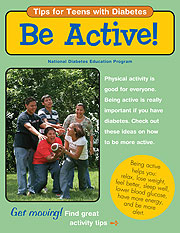
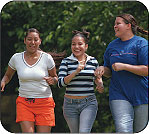 Being active keeps your body healthy and strong and gives you more
energy. It can help you think and be more alert in school. It can also
help you stay at a healthy weight or help you lose weight slowly.
Being active is an important part of a healthy lifestyle.
Being active keeps your body healthy and strong and gives you more
energy. It can help you think and be more alert in school. It can also
help you stay at a healthy weight or help you lose weight slowly.
Being active is an important part of a healthy lifestyle.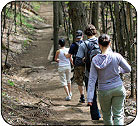 There are many ways you can be active. Pick things you like to do.
There are many ways you can be active. Pick things you like to do. Talk to your doctor about the types of physical activity that might work best for you.
Talk to your doctor about the types of physical activity that might work best for you.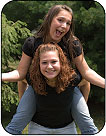 You do not have to play a
sport or go to a gym. There are a lot of things you can do to be more active:
You do not have to play a
sport or go to a gym. There are a lot of things you can do to be more active: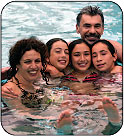 Ask your family members and friends
to do something fun with you—and work up a sweat. Being active is good
for them too and a great way for families to spend time together. Ask
your family to take a walk after dinner instead of watching TV. Instead of
computer games, play music that the whole family likes and dance!
Ask your family members and friends
to do something fun with you—and work up a sweat. Being active is good
for them too and a great way for families to spend time together. Ask
your family to take a walk after dinner instead of watching TV. Instead of
computer games, play music that the whole family likes and dance! to promote physical activity for teens in their community
to promote physical activity for teens in their community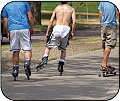 If you have diabetes, you need to be active, make healthy food choices, and stay at a healthy weight. You also need to take your insulin or any other medicines that your doctor tells you to and check your blood glucose as planned with your health care team. Taking care of your diabetes can help you stay fit, feel great, and give you more energy to have fun.
If you have diabetes, you need to be active, make healthy food choices, and stay at a healthy weight. You also need to take your insulin or any other medicines that your doctor tells you to and check your blood glucose as planned with your health care team. Taking care of your diabetes can help you stay fit, feel great, and give you more energy to have fun. National Diabetes Education Program
National Diabetes Education Program







